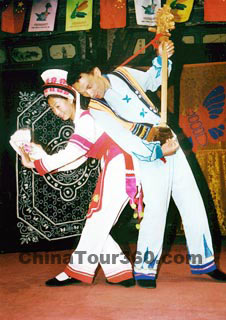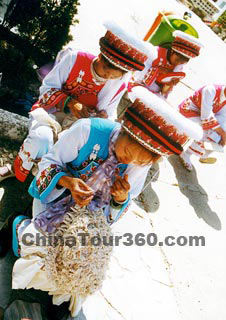
Dance of Bai Minority
The Bai ethnic group has a population of around 2 million, 90 percent of which live in the Bai Autonomous County west of Yunnan Province. Only a small part of their community are scattered in Sichuan, Guizhou, and Hunan Provinces.
The language of Bai belongs to the Yi branch of Zang-Mian Austronesian of Han-Zang Phylum. They have also invented their own written characters by referring to the Han's characters. Thus, you will find that many words are in fact taken from the Han language. However, Chinese is the most widely use language among the Bai people today.
The ethnic group has had a long history. Its ancestors used to be called 'Kunming' in the Han and Jin Dynasties. In successive dynasties, they were named 'Heman', 'Baiman' and 'Bairen'. Since the founding of the P.R.C, they have been formally named the 'Bai' ethnic group because of their worship of the color white.
The Bai ethnic group mainly deals with agriculture and fishery. Main crops are rice, winter wheat, beans, millet, cotton, rape, sugar-cane and tobacco. People living in plains take rice and wheat as their staple food and those in mountain areas mostly depend on corn, yam and buckwheat. Pork is their everyday basic meat. Pickles, brawns, and bean sauce arepopular snacks among Bai people.
The Bai people mainly believe in 'Benzhu' (village god). In each village and region, the Benzhu has a different meaning attached to it. Some are referred to as the God of Nature, others as national heroes, famous officers, and as loyal women. A small group of them also believe in ghosts and Buddhism.
The Bai people prefer the color white. Men like to wear white shirts while Women's clothing differs from place to place. Women in the Dali region wear white shirts, and red waistcoats. All Bai people wear a piece of sheepskin. Women in areas east of Erhai Lake are fond of the hairstyle 'Fengdiantou', meaning phoenix lowers head whereby the head is bound with a black or embroidered cloth.

Women of Bai Nationality
You will find that the Bai people are good singers and dancers. The 'Lion Dance', created during the Nanzhao regime, was appreciated in the central plains during the Tang Dynasty (618 - 907). Bai opera, known as chuichui, is an art form combining folk music and dancing. It has also absorbed some of the characteristics of Han operas.
The traditional festivals of Bai ethnic group include: the March Fair and the Torch Festival. The March Fair, which falls between March 15 and 20 of the lunar calendar, is a grand festival of the Bai ethnic group. It is celebrated every year at the foot of the Diancang Hill to the west of Dali city. It is a fair as well as an occasion for sporting contests and theatrical performances. People gather there to enjoy dances, horse racing and other games.
The Torch Festival is held on June 25. Torches are lit everywhere to usher in a bumper harvest and to bless the people with good health and fortune. Streamers bearing auspicious words are hung in doorways and at village entrances alongside the flaming torches. Villagers, holding aloft torches, walk around in the fields to drive insects away.
![]() More ethnic minorities of China: Blang Bonan Bouyei Chaoxian
More ethnic minorities of China: Blang Bonan Bouyei Chaoxian







